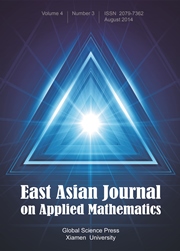Article contents
Coefficient of Variation Based Image Selective Segmentation Model Using Active Contours
Published online by Cambridge University Press: 28 May 2015
Abstract
Most image segmentation techniques efficiently segment images with prominent edges, but are less efficient for some images with low frequencies and overlapping regions of homogeneous intensities. A recently proposed selective segmentation model often works well, but not for such challenging images. In this paper, we introduce a new model using the coefficient of variation as a fidelity term, and our test results show it performs much better in these challenging cases.
Keywords
- Type
- Research Article
- Information
- Copyright
- Copyright © Global-Science Press 2012
References
[1]Ahmed, S. E.. A pooling methodology for coefficient of variation. Sankhya: The Indian Journal of Statistics, 57(B1):57–75, 1995.Google Scholar
[2]Adams, R. and Bischof, L.. Seeded region growing. IEEE Transactions on Pattern Analysis and Machine Intelligence, 16(6):641–647, 1994.Google Scholar
[3]Badshah, N. and Chen, K.. Image selective segmentation under geometrical constraints using an active contour approach. Mathematics of Computation, 7:759–778, 2010.Google Scholar
[4]Barash, D. and Kimmel, R. An accurate operator splitting scheme for nonlinear diffusion filtering. HP Laboratories Israel1 HPL-2000-48(R.1) August 1st, 2000Google Scholar
[5]Caselles, V., Kimmel, R., and Sapiro, G.. Geodesic active contours. International Jornal of Computervision, 22(1):61–79, 1997.Google Scholar
[6]Chan, T. F. and Vese, L. A.. Active contours without edges. IEEE Transactions on Image Processing, 10(2):266–277, 2001.CrossRefGoogle ScholarPubMed
[7]Chen, K.. Matrix Preconditioning Techniques and Applications. Cambridge University Press, 2005.Google Scholar
[8]Cohen, L. D.. On active contour models and balloons. Computer Vision, Graphics, and Image Processing: Image Understanding, 53(2):211–218, 1991.Google Scholar
[9]Douglas, J. and Rachford, H. H.. On the numerical solution of heat conduction problems in two and three space variables. Transactions of the American Mathematical Society, 82:421–439, 1956.CrossRefGoogle Scholar
[10]Gout, C., Guyader, C. L., and Vese, L. A.. Segmentation under geometrical conditions with geodesic active contour and interpolation using level set method. Numerical Algorithms, 39:155–173, 2005.CrossRefGoogle Scholar
[11]Guyader, C. L. and Gout, C.. Geodesic active contour under geometrical conditions theory and 3D applications. Numerical Algorithms, 48:105–133, 2008.Google Scholar
[12]Jeon, M., Alexander, M., Pedrycz, W., and Pizzi, N.. Unsupervised hierarchical image segmentation with level set and additive operator splitting. Pattern Recognition Letters, 26(10):1461–1469, 2005.CrossRefGoogle Scholar
[13]Kass, M., Witkin, A., and Terzopoulos, D.. Snakes: Active contours models. International Jornal of Computer Vision, 1:321–331, 1988.Google Scholar
[14]Leclerc, Y.. Region growing using the MDL principle. In: DARPA Image Understanding Workshop, 1990.Google Scholar
[15]Li, Y. B. and Kim, J. S.. Multiphase image segmentation using a phase-field model. Computers and Mathematics with Applications, 62:737–745, 2011.Google Scholar
[16]Lu, T., Neittaanmaki, P., and Tai, X. C.. A parallel splitting up method and its application to Navier-Stokes equations. Applied Mathematics Letters, 4(2):25–29, 1991.Google Scholar
[17]Mora, M., Tauber, C., and Batatia, H.. Robust level set for heart cavities detection in ultrasound images. Computers in Cardiology, 32:235–238, 2005.Google Scholar
[18]Mumford, D. and Shah, J.. Optimal approximation by piecewise smooth functions and associated variational problems. Communications on Pure Applied Mathematics, 42:577–685, 1989.CrossRefGoogle Scholar
[19]Osher, S. and Fedkiw, R.. Level Set Methods and Dynamic Implicit Surfaces, Springer Verlag, 2003.CrossRefGoogle Scholar
[20]Osher, S. and Sethian, J. A.. Fronts propagating with curvature-dependent speed: Algorithms based on Hamilton-Jacobi formulations. Journal of Computational Physics, 79(1):12–49, 1988.Google Scholar
[21]Schulze, M. A. and Wu, Q. X.. Nonlinear edge-preserving smoothing of synthetic aperture radar images. Proceedings of the New Zealand Image and Vision Computing '95 Workshop, pp. 65–70, 1995.Google Scholar
[22]Sethian, J. A.. Level Set Methods and Fast Marching Methods: Evolving Interfaces in Computational Geometry, Fluid Mechanics, Computer Vision and Material Science, Cambridge University Press, 1999.Google Scholar
[23]Vese, L. A. and Chan, T. F.. A multiphase level set framework for image segmentation using the Mumford and Shah model. International Journal of Computer Vision, 50(3):271–293, 2002.Google Scholar
[24]Vincent, L. and Soille, P. Watersheds in digital spaces – An efficient algorithm based on immersion. IEEE Transactions Pattern Analysis and Machine Learning, 13(6):583–598, 1994.Google Scholar
[25]Weickert, J., Romeny, B. M. T. H., and Viergever, M. A.. Efficient and reliable schemes for nonlinear diffusion filtering. IEEE Transactions On Image Processing, 7:398–410, 1998.Google Scholar
[26]Weickert, J. and Kühne, G.. Fast methods for implicit active contours models. Geometric Level Set Methods in Imaging, Vision, and Graphics, Part II, 43–57, 2003.Google Scholar
[27]Yu, Y. and Acton, S. T.. Edge detection in ultrasound imagery using the instantaneous coefficient of variation. IEEE Transactions On Image Processing, 13(12):1640–1655, 2004.Google Scholar
- 32
- Cited by


